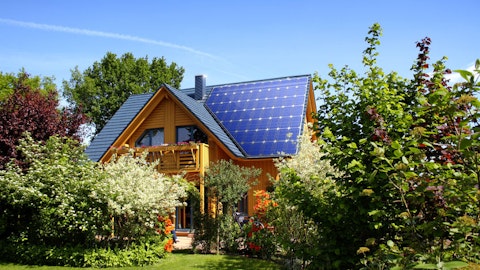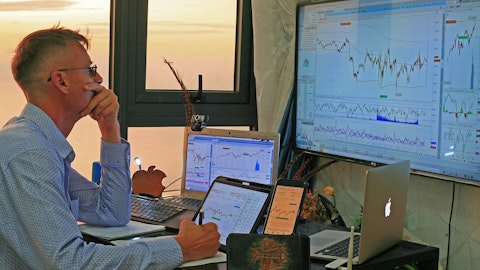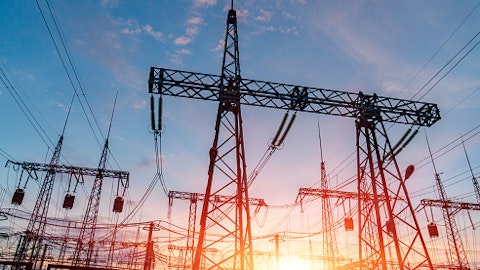Julien Dumoulin-Smith : Hi. Good morning, team. Thank you for the time here. Just first following up with the backlog. Just can you elaborate a little bit on what you’re seeing here? It seems like you’re adding beyond 2026. How are you thinking about potential for acceleration here off of the numbers that you’ve articulated thus far in the four-year period? And then related how much of that is hydrogen in total if you can kind of give us at least some initial disclosure on that front.
Rebecca Kujawa : Thanks Julien. It’s Rebecca. I’ll take that. So we continue to feel and I didn’t directly answer Steve’s question, so I appreciate you giving me another shot at it. I feel very good about our development expectations across the board. Obviously, we’re now — we’re at the low end of the range for 2023 and 2024 and continue to feel very well positioned to meet the longer-term expectations across the four-year period. And with the comments I just made and Kirk made on the call, we couldn’t be more excited about what’s beyond the 2026 time frame. I do think the hydrogen opportunity is probably more — not probably, it is definitively more past 2026 than in 2026 for a lot of practical reasons, not the least of which is needing clarity on the treasury guidance, which of course affects the customer discussions that we’re having today.
It also affects the way manufacturers are committing to their ramp-up of their capabilities to produce electrolyzers in particular. And, of course, as that clarity comes to fruition and hopefully in particular we realize the annual matching guidance for the hydrogen production tax credit all of that will start to accelerate. And then on top of that, we continue to see tremendous innovation across the clean tech space. Just over the last two years I was looking at the numbers from Bloomberg New Energy Finance and its $100 billion invested in clean tech across the venture capital space. So just tremendously exciting innovations that we’re seeing and I think will really make a huge difference in the latter part of this decade.
Julien Dumoulin-Smith: Excellent. And just quickly going back to NEP quickly. How do you think about using ATM to buy out the remaining CPIF they come due? Further should we assume issuing new CPIF on a rolling basis as credit facilities are refinanced right again obviously right now this is temporary financing in some respects. And then ultimately how do you think about the IDR potential holidays and other tools in the current environment?
Kirk Crews: All right. So Julien I’ll try to work off all those questions and the team will make sure I get to them all. So the first question was around the use of the ATM. So look as we shared in the prepared remarks, we have the flexibility to be opportunistic to use — to deliver to the investor either directly units or to use the ATM on the buyouts. And so you should expect us to use that flexibility and to be opportunistic around those options. And so if we go to the ATM, there’s some value to go into the ATM at times to deliver. And there’s also — there will be times where it’s just beneficial to deliver the units. So we have both those tools and we can use them. In terms of using unit CPIF in the future. As we share today the CPIF have provided benefits for unitholders.
And when you compare it to the alternative, which is doing an underwritten block equity deal when you compare those two as we presented on the slide, it has saved unitholders considerably more than 16 million units. And when you compare those two, I think that slide is — does a really nice job laying out the benefits. And so as we’ve always done, we will look at what’s the best financing option when it’s time to finance an acquisition. And we look at all the different financing tools that we have. And as we shared today when we build our financing plan and when we think about delivering on our LP distribution growth, we build a financing plan into those financing expectations and that includes the conversion of the outstanding units. And certainly, if we’re going to use a new CEPF, we will build that into the financing plan and what that means in terms of being able to continue to deliver on the expectations.
And I believe your third question was around what are the other — is there going to be something around an IDR holiday or something like that. Look, as I shared in responding to Steve’s comment, we have tremendous growth opportunities and in tremendous growth visibility at NextEra Energy Partners. We have a lot of flexibility in terms of being able to finance that growth. The acquisition that we announced today I think is a really strong indication of how we can acquire a very attractive set of assets for unitholders. And so we feel very good about being able to acquire assets and support growth. And so we’re focused on being able to tap into that growth visibility and deliver to unitholders that way.
John Ketchum: Julien this is John. Let me just add on a little bit about the ATM and the ability to issue shares directly to CEPF investors. Our first preference I think would be to issue shares directly to CEPF investors. This was a situation where we were able to use the ATM for the first 50% of the STX buyout very opportunistically and we could do it basically at a zero discount and it made a lot of sense to be able to do it that way. It’s great to have the flexibility when you have opportunities like that that are presented by the ATM to be able to execute on them. So it’s a nice tool to have in the toolkit. But again, we have ultimate flexibility in terms of — if opportunities present themselves that are very attractive under the ATM, we can explore those opportunities.
But again, we always have the chance to just give the shares directly to the CEPF holder. We’re always going to do whatever is most efficient for unitholders. We had a slide in the deck today that I think demonstrates the value of the CEPF, the 54% savings on the BlackRock conversion back in 2018, roughly the 65% 66% savings in the 50% STX buyout that we’ve accomplished so far today. But at NEP, right now we are very focused on execution for the things that Kirk has already gone through. We’ve got great growth visibility, attractive acquisition today at a 9.5% CAFD yield. And we have a lot of ways to finance the business going forward. There’s never been more capital chasing renewables than there is today. There are billions and billions and billions of dollars sitting on the sidelines, waiting to find a home around renewable assets.
So I feel very good about the way NEP is positioned. NEP is also very important to NEE. It’s a great way to recycle capital that provides tax optimization benefits. We continue to get distributions from assets that we drop into NEP. So the relationship between the two companies is very strong and has been very successful for both. We’ve got a lot of levers, NEP is very well positioned.
Julien Dumoulin-Smith: Thank you, guys.
Operator: The next question comes from Shar Pourreza with Guggenheim Partners. Please go ahead.
Shar Pourreza: Hey, guys. Good morning. Just real quick on rounding out on NEP. So I guess the latest portfolio acquisition, the midpoint CAFD yield, 9.5%. It’s a bit higher than some of the prior ones. I guess, do you still see attractive economics on new acquisitions? Is it enough to balance out the dilution from the legacy CEPF conversions. So I guess I’m kind of asking a question on accretive economics versus the cost of capital there?
Rebecca Kujawa: Shar, I think the answer very simply is, yes. We think there are tremendously attractive acquisitions for NEP. And as John just highlighted, Energy Resources finds itself in a position of wanting to recycle capital. So there’s a lot of synergy in that. And I think we will always continue to focus on current market conditions when we’re thinking about divestitures from a year perspective and acquisitions from a net perspective. And as Kirk highlighted and John emphasized, we factor all of that in as we think about the expectations for NEP going forward and remain very comfortable with NEP’s ability to grow the 12% to 15% distributions per unit through 2026 as we reiterated. And having a tremendous amount of both financing flexibility and visibility to that growth through all the avenues that Kirk highlighted.
Shar Pourreza: Got it. And then just on NextEra in general in terms of sort of the inputs we’ve seen, you guys have announced several earnings accretive data points since last year, right? You’ve got RNG acquisition hydrogen, organic transmission growth and some incremental visibility on FPL solar deployment. Do any of these investments kind of displace the CapEx, you guys embedded in plan at the Analyst Day? Is there any sort of headwinds we should be thinking about? And ultimately, do you anticipate this to start being accretive to your plan from let’s say 2025 to 2026 time frame especially, as we’re thinking about the six to eight.
Kirk Crews: So Shar, this is Kirk. Look, we are always – as you know capital is fungible. We’re always looking at what all kinds of investment opportunities we have. We lay out – when we laid out the plan at the investor conference, that was certainly pre-IRA. The world has changed a little bit as a result of that. But fundamentally, we feel very good about executing and delivering on the adjusted EPS expectations that we laid out. We obviously are before – at the time of the Investor Day, hydrogen wasn’t an economic product. Green hydrogen was not an economic product. It is today because of the IRA and so we’re running hard at it. But as Rebecca also outlined, the reality is that is probably a post-2026 realization in terms of what – how it’s going to translate into benefits.
So there’s a lot that we’re running after and a lot we’re looking at. But most of this is things that we were evaluating and thinking about at the time of the investor conference or things that are going to really come to fruition post-2026 and really either part of the plans post plans but all things that are supporting ultimately the things that we laid out and feel comfortable about in terms of delivering adjusted EPS for 2026.
Shar Pourreza: Terrific. Thank you guys. Appreciate it.
Operator: The next question comes from Jeremy Tonet with JPMorgan. Please go ahead.
Jeremy Tonet: Hi, good morning.
Kirk Crews: Hi, good morning.
Jeremy Tonet: Just wanted to touch base a little bit more on supply chain if you could. If you might be able to provide a bit more commentary on how flow panels stand today versus a few years back and also as well as bringing the supply chain onshore. Just wondering if you could provide a little bit more color on how what time line you see that finalizing?
Kirk Crews: Sure. So, as we shared in our prepared remarks I mean we’ve spent a lot of time thinking about supply chain working with suppliers. It has been a very comprehensive effort. It’s been looking both globally and then obviously here domestically as well. Look there’s lots of things to think through domestically. We’re continuing to work through that as well. It is about trying to evaluate where in the supply chain there might be opportunities in terms of how to participate. But the way to think about that Jeremy is our view has always been we could be supportive through an anchor order, we could help provide support through that mechanism. That continues to be our preferred approach. And we’re working with various potential partners in discussions that way and that’s continued those discussions continue to occur.
Jeremy Tonet: Got it. And just flow panels today, just wondering how that stacks up versus where it was a few years ago?
John Ketchum: Yes. This is John. So, the flow of panels is going very well. As Kirk said we’ve been active with Customs Border Patrol and panels are now flowing through the ports, really don’t see any material delays to any of our projects, so we feel good about that. And as Kirk said I mean we’re in active — the great thing about a company like NextEra with the capital spend that we have and the sophistication that we have around running a global supply chain, we have a lot of options — a lot of options, a diversified set of options globally and we’re exercising those options and we’re exploring new opportunities as well. Obviously, there’s a lot of interest in working directly with NextEra given the amount of buying power that we have.
We will always be the preferred customer for each of these — just given the scale at which we purchase and that allows us to drive attractive arrangements, which we think will really help make the business even more competitive going forward. And so, we have launched a number of those efforts, both domestically and looking at some other diversification opportunities globally that will even better position the business, than it’s ever been before, going forward to really capitalize on the competitive advantage we have in terms of the buying power around the supply chain.
Jeremy Tonet: Got it. That’s helpful. I’ll leave it there. Thanks.
Operator: The next question comes from Durgesh Chopra with Evercore ISI. Please go ahead.





